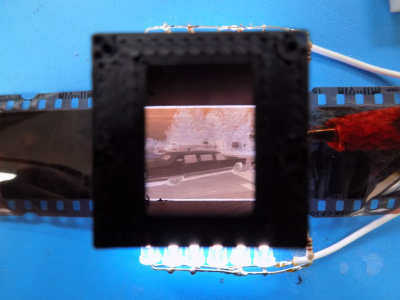Not so long ago, taking pictures was a much more sacred thing. Film and processing were expensive compared to the digital way, and since you couldn’t just delete a picture off the camera and get your film back, people tended to be much more selective about the pictures they took. Even so, for every roll of film, there was usually at least one stinker. If you’ve made it your quest to digitize the past, you’ll quickly realize that they’re not all gems, and that some can be left to languish.
 [Random_Canadian] recently found himself knee-deep in negatives, but wanted an easy way to weed out the mediocre memories. With this film negative viewer and converter, he can step through the pictures one by one on a big screen and decide which ones to keep.
[Random_Canadian] recently found himself knee-deep in negatives, but wanted an easy way to weed out the mediocre memories. With this film negative viewer and converter, he can step through the pictures one by one on a big screen and decide which ones to keep.
The Pi uses the negative image effect to turn the negatives positive, and then outputs them to the TV. If [Random_Canadian] finds one worth bringing into the 21st century, he pushes the green button to take a picture with the Pi camera and save it to that awesome cryptex USB drive. When he’s tired of walking down memory lane, he pushes the red button to exit the program.
We especially like that [Random_Canadian] made his own light panel by edge-lighting a piece of 6 mm Lexan. Fresh out of flat-topped LEDs, he made his own by grinding down some regular ones on a belt sander.
Got some old 8mm film you want to digitize? Check out this beautiful automated film scanner.
















I picked up a slide scanner at a flea market for a couple of bucks and it had a negative strip feed as well. I had a lot of fun going through my old negatives. For me, there has been kind of a rift in my stuff. Some prints I made decades ago on the walls and tons of negatives, but nothing from the pre digital era on line. The scanner made it easy and surprisingly fun to play with photos from the past, and have a digital end product.
Very cool, I’ve been keeping an eye out for a relatively inexpensive way to scan negatives. This might be it.
If you’re looking to capture them instead of just view them, check out:
https://discuss.pixls.us/t/diy-copy-stand-for-dslr-scanning/14833
I use a zoom slide copier (zsd)
Available online and simply screws onto the front of your camera lens.
http://waughstories.blogspot.com/2010/12/my-reputation-was-saved-by-zsd.html?m=1
We do it similar at work but with various film formats. Best thing for converting negatives to positive has been for us this imagemagik script: http://www.fmwconcepts.com/imagemagick/negative2positive/index.php
The 50 Mpix Eos 5DS with a good macro lens helps a lot too …
If you’re shooting with a DSLR or mirrorless with a macro lens, you might want to take a look at RawTherapee’s film inversion feature. I’ve found it to work better than any other approach I’ve tried.
If it can be automated, yes. But the imagemagick script runs of a cronjob and every picture we throw in a special folder will be converted automatically with quite good results.
I’ve looked at so many negative films that I eventually developed an ability to invert them in my mind. Fun times.
BTW, I am really liking the white background HaD is using.